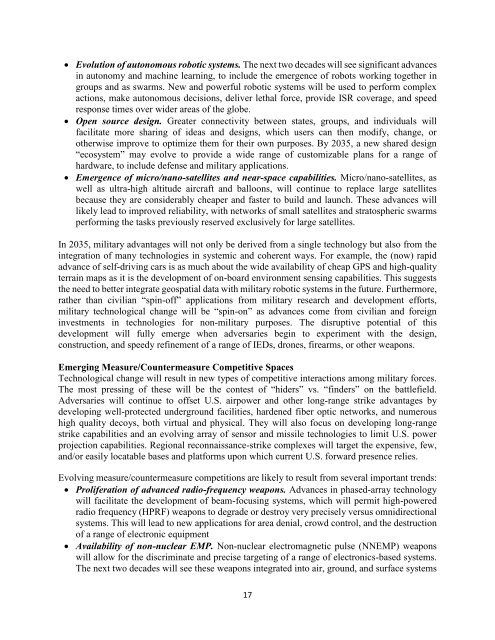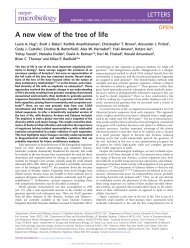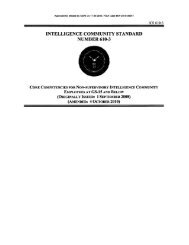The Joint Force in a Contested and Disordered World
JCS-JOE-2035
JCS-JOE-2035
Create successful ePaper yourself
Turn your PDF publications into a flip-book with our unique Google optimized e-Paper software.
Evolution of autonomous robotic systems. <strong>The</strong> next two decades will see significant advances<br />
<strong>in</strong> autonomy <strong>and</strong> mach<strong>in</strong>e learn<strong>in</strong>g, to <strong>in</strong>clude the emergence of robots work<strong>in</strong>g together <strong>in</strong><br />
groups <strong>and</strong> as swarms. New <strong>and</strong> powerful robotic systems will be used to perform complex<br />
actions, make autonomous decisions, deliver lethal force, provide ISR coverage, <strong>and</strong> speed<br />
response times over wider areas of the globe.<br />
Open source design. Greater connectivity between states, groups, <strong>and</strong> <strong>in</strong>dividuals will<br />
facilitate more shar<strong>in</strong>g of ideas <strong>and</strong> designs, which users can then modify, change, or<br />
otherwise improve to optimize them for their own purposes. By 2035, a new shared design<br />
“ecosystem” may evolve to provide a wide range of customizable plans for a range of<br />
hardware, to <strong>in</strong>clude defense <strong>and</strong> military applications.<br />
Emergence of micro/nano-satellites <strong>and</strong> near-space capabilities. Micro/nano-satellites, as<br />
well as ultra-high altitude aircraft <strong>and</strong> balloons, will cont<strong>in</strong>ue to replace large satellites<br />
because they are considerably cheaper <strong>and</strong> faster to build <strong>and</strong> launch. <strong>The</strong>se advances will<br />
likely lead to improved reliability, with networks of small satellites <strong>and</strong> stratospheric swarms<br />
perform<strong>in</strong>g the tasks previously reserved exclusively for large satellites.<br />
In 2035, military advantages will not only be derived from a s<strong>in</strong>gle technology but also from the<br />
<strong>in</strong>tegration of many technologies <strong>in</strong> systemic <strong>and</strong> coherent ways. For example, the (now) rapid<br />
advance of self-driv<strong>in</strong>g cars is as much about the wide availability of cheap GPS <strong>and</strong> high-quality<br />
terra<strong>in</strong> maps as it is the development of on-board environment sens<strong>in</strong>g capabilities. This suggests<br />
the need to better <strong>in</strong>tegrate geospatial data with military robotic systems <strong>in</strong> the future. Furthermore,<br />
rather than civilian “sp<strong>in</strong>-off” applications from military research <strong>and</strong> development efforts,<br />
military technological change will be “sp<strong>in</strong>-on” as advances come from civilian <strong>and</strong> foreign<br />
<strong>in</strong>vestments <strong>in</strong> technologies for non-military purposes. <strong>The</strong> disruptive potential of this<br />
development will fully emerge when adversaries beg<strong>in</strong> to experiment with the design,<br />
construction, <strong>and</strong> speedy ref<strong>in</strong>ement of a range of IEDs, drones, firearms, or other weapons.<br />
Emerg<strong>in</strong>g Measure/Countermeasure Competitive Spaces<br />
Technological change will result <strong>in</strong> new types of competitive <strong>in</strong>teractions among military forces.<br />
<strong>The</strong> most press<strong>in</strong>g of these will be the contest of “hiders” vs. “f<strong>in</strong>ders” on the battlefield.<br />
Adversaries will cont<strong>in</strong>ue to offset U.S. airpower <strong>and</strong> other long-range strike advantages by<br />
develop<strong>in</strong>g well-protected underground facilities, hardened fiber optic networks, <strong>and</strong> numerous<br />
high quality decoys, both virtual <strong>and</strong> physical. <strong>The</strong>y will also focus on develop<strong>in</strong>g long-range<br />
strike capabilities <strong>and</strong> an evolv<strong>in</strong>g array of sensor <strong>and</strong> missile technologies to limit U.S. power<br />
projection capabilities. Regional reconnaissance-strike complexes will target the expensive, few,<br />
<strong>and</strong>/or easily locatable bases <strong>and</strong> platforms upon which current U.S. forward presence relies.<br />
Evolv<strong>in</strong>g measure/countermeasure competitions are likely to result from several important trends:<br />
Proliferation of advanced radio-frequency weapons. Advances <strong>in</strong> phased-array technology<br />
will facilitate the development of beam-focus<strong>in</strong>g systems, which will permit high-powered<br />
radio frequency (HPRF) weapons to degrade or destroy very precisely versus omnidirectional<br />
systems. This will lead to new applications for area denial, crowd control, <strong>and</strong> the destruction<br />
of a range of electronic equipment<br />
Availability of non-nuclear EMP. Non-nuclear electromagnetic pulse (NNEMP) weapons<br />
will allow for the discrim<strong>in</strong>ate <strong>and</strong> precise target<strong>in</strong>g of a range of electronics-based systems.<br />
<strong>The</strong> next two decades will see these weapons <strong>in</strong>tegrated <strong>in</strong>to air, ground, <strong>and</strong> surface systems<br />
17











